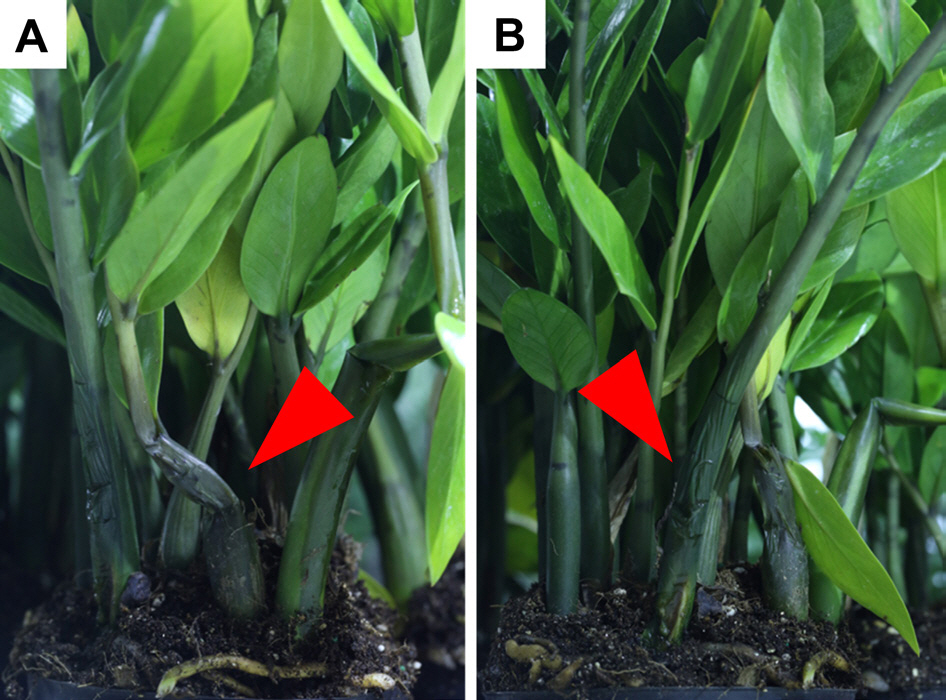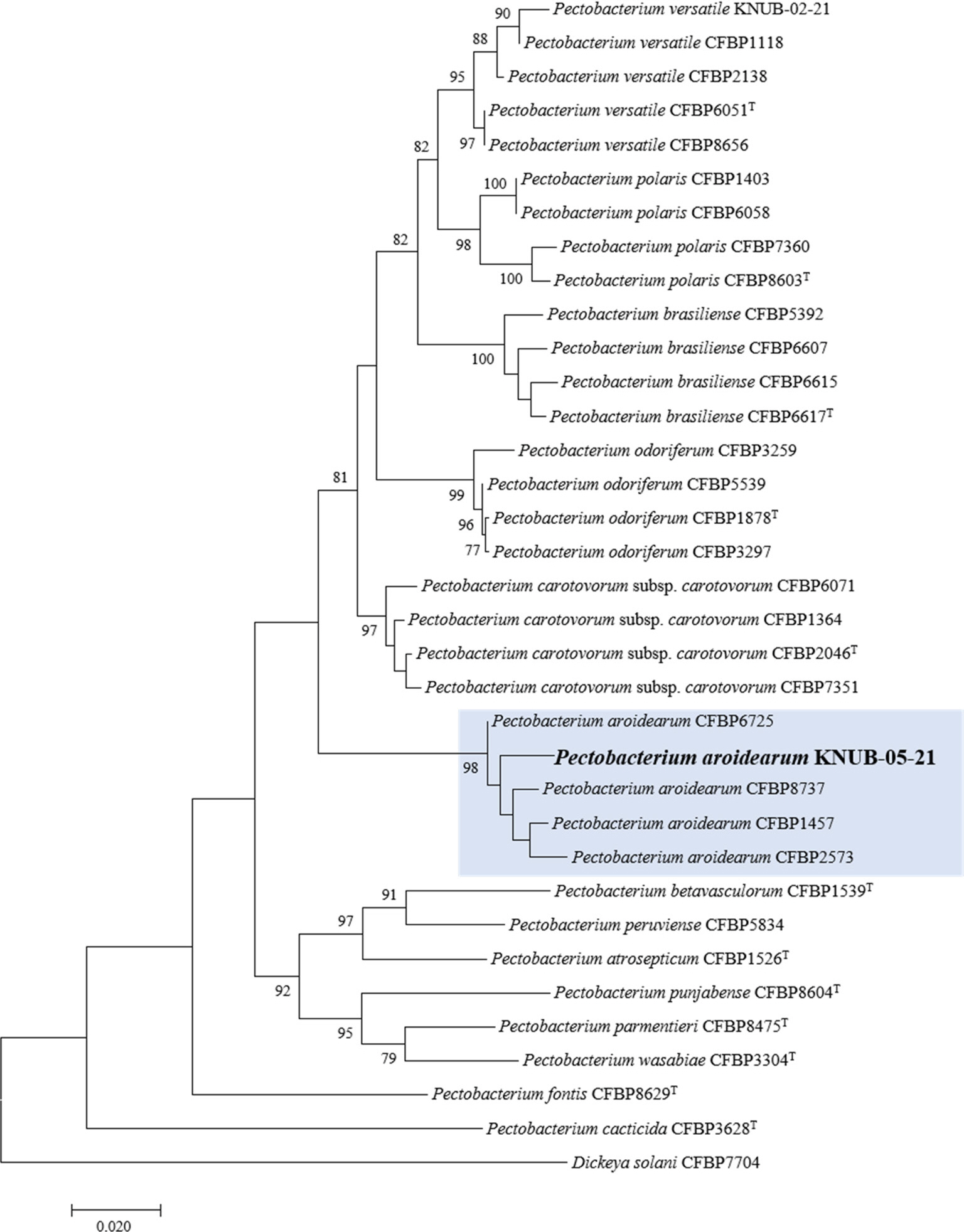Duarte, V., de Boer, S. H., Ward, L. J. and de Oliveira, A. M. R. 2004. Characterization of atypical
Erwinia carotovora strains causing blackleg of potato in Brazil.
J. Appl. Microbiol. 96: 535-545.


Felsenstein, J. 1981. Evolutionary trees from DNA sequences: a maximum likelihood approach.
J. Mol. Evol. 17: 368-376.



Han, W., Wang, J., Pirhonen, M., Pan, Y., Qin, J., Zhang, S. et al. 2023. Identification and characterization of opportunistic pathogen
Pectobacterium polonicum causing potato blackleg in China.
Front. Plant Sci. 14: 1097741.



Jin, Y. J., Jo, D., Kwon, S.-W., Jee, S., Kim, J.-S., Raman, J. et al. 2022. A new approach using the SYBR green-based real-time PCR method for detection of soft rot
Pectobacterium odoriferum associated with kimchi cabbage.
Plant Pathol. J. 38: 656-664.




Li, L., Yuan, L., Zhao, Y., Shi, Y., Chai, A., Xie, X. et al. 2022. Emergence of bacterial soft rot in calla lily caused by
Pectobacterium aroidearum in China.
Crop Prot. 152: 105854.

Ma, B., Hibbing, M. E., Kim, H.-S., Reedy, R. M., Yedidia, I., Breuer, J. et al. 2007. Host range and molecular phylogenies of the soft rot enterobacterial genera
Pectobacterium and
Dickeya.
Phytopathology 97: 1150-1163.


Mikiciński, A., Warabieda, M., Nowak, J. S. and Puławska, J. 2023. First report on
Pectobacterium aroidearum, a new pathogen causing soft rot on alocasia (
Alocasia amazonica) in Poland.
J. Plant Pathol. 105: 1169-1170.


Moraes, A. J. G., Baia, A. D. B., Souza, E. B., Peixoto, A. R., Barroso, K. A., Almeida, C. O. et al. 2020. First report of
Pectobacterium aroidearum causing soft rot of pepper (
Capsicum annuum) fruits in Brazil.
Plant Dis. 104: 3054.

Moraes, A. J. G., Souza, E. B., Mariano, R. L. R., Silva, A. M. F., Lima, N. B., Peixoto, A. R. et al. 2017. First report of
Pectobacterium aroidearum and
Pectobacterium carotovorum subsp.
brasiliensis causing soft rot of
Cucurbita pepo in Brazil.
Plant Dis. 101: 379.

Nabhan, S., De Boer, S. H., Maiss, E. and Wydra, K. 2012a. Taxonomic relatedness between
Pectobacterium carotovorum subsp.
carotovorum, Pectobacterium carotovorum subsp.
odoriferum and
Pectobacterium carotovorum subsp.
brasiliense subsp. nov.
J. Appl. Microbiol. 113: 904-913.


Nabhan, S., De Boer, S. H., Maiss, E. and Wydra, K. 2013.
Pectobacterium aroidearum sp. nov., a soft rot pathogen with preference for monocotyledonous plants.
Int. J. Syst. Evol. Microbiol. 63: 2520-2525.


Nabhan, S., Wydra, K., Linde, M. and Debener, T. 2012b. The use of two complementary DNA assays, AFLP and MLSA, for epidemic and phylogenetic studies of pectolytic enterobacterial strains with focus on the heterogeneous species
Pectobacterium carotovorum.
Plant Pathol. 61: 498-508.

Park, K.-T., Hong, S.-M., Back, C.-G., Cho, Y.-J., Lee, S.-Y., Ten, L. N. et al. 2023a. First report of
Pectobacterium versatile as the causal pathogen of soft rot in kimchi cabbage in Korea.
Res. Plant Dis. 29: 72-78.


Park, K.-T., Hong, S.-M., Back, C.-G., Kang, I.-K., Lee, S.-Y., Ten, L. N. et al. 2023b.
Pectobacterium brasiliense as a causative agent for soft rot of radish in Korea.
Res. Plant Dis. 29: 64-71.


Park, K.-T., Hong, S.-M., Back, C.-G., Kim, S. Y., Lee, S.-Y., Kang, I.-K. et al. 2022. First report of
Pectobacterium brasiliense causing soft rot on graft cactus in Korea.
Res. Plant Dis. 28: 172-178.


P├®rombelon, M. C. M. 2002. Potato diseases caused by soft rot erwinias: an overview of pathogenesis.
Plant Pathol. 51: 1-12.


Portier, P., P├®dron, J., Taghouti, G., Saux, M. F.-L., Caullireau, E., Bertrand, C. et al. 2019. Elevation of
Pectobacterium carotovorum subsp.
odoriferum to species level as
Pectobacterium odoriferum sp. nov., proposal of
Pectobacterium brasiliense sp. nov. and
Pectobacterium actinidiae sp. nov., emended description of
Pectobacterium carotovorum and description of
Pectobacterium versatile sp. nov., isolated from streams and symptoms on diverse plants.
Int. J. Syst. Evol. Microbiol. 69: 3207-3216.


Sanahuja, G., Lopez, P. and Palmateer, A. J. 2016. First report of
Phytophthora nicotianae causing foliar blight on
Zamioculcas zamiifolia in Florida.
Plant Dis. 100: 864.

Seo, Y., Park, M.-J., Back, C.-G. and Park, J.-H. 2019. First report of stem rot caused by
Athelia rolfsii on
Zamioculcas zamiifolia in Korea.
Plant Dis. 103: 2965.

Sławiak, M., van Beckhoven, J. R. C. M., Speksnijder, A. G. C. L., Czajkowski, R., Grabe, G. and van der Wolf, J. M. 2009. Biochemical and genetical analysis reveal a new clade of biovar 3
Dickeya spp. strains isolated from potato in Europe.
Eur. J. Plant Pathol. 125: 245-261.


Stutz, M. C., Filho, R. C., Rocha, G. A., Dianese, ├ē. D. C. and Cunha, M. G. D. 2020. Soft rot on the stems of
Zamioculcas zamiifolia caused by
Sclerotium rolfsii.
Ornam. Hortic. 25: 402-406.

Tang, W.-Q., Chang, C.-Y., Lee, Y.-J. and Chu, C.-C. 2021. First report of
Pectobacterium aroidearum causing bacterial soft rot of carrot in Taiwan.
Plant Dis. 105: 695.

Teoh, S. H., Wong, G. R., Teo, W. F. A. and Mazumdar, P. 2023. First report of
Pectobacterium carotovorum and
Pectobacterium aroidearum causing bacterial soft rot on curly dwarf pak choy (
Brassica rapa var.
Chinensis) in Malaysia. Plant Dis. Advanced online publication,
https://doi.org/10.1094/PDIS-06-23-1239-PDN


Toabaita, M., Vangnai, A. S. and Thiravetyan, P. 2016. Removal of ethylbenzene from contaminated air by
Zamioculcas zamiifolia and microorganisms associated on
Z. zamiifolia leaves.
Water Air Soil Pollut. 227: 115.


Waleron, M., Waleron, K., Podhajska, A. J. and Łojkowska, E. 2002. Genotyping of bacteria belonging to the former
Erwinia genus by PCR-RFLP analysis of a
recA gene fragment.
Microbiology 148: 583-595.


Wei, H.-Y., Yang, M., Pei, W.-H., Wei, W., Huang, F.-Y., Liu, J.-N. et al. 2020. First report of
Pectobacterium aroidearum causing soft rot of
Amorphophallus konjac in China.
Plant Dis. 104: 969.

Xie, H., Li, X. Y., Ma, Y. L. and Tian, Y. 2018. First report of
Pectobacterium aroidearum causing soft rot of Chinese cabbage in China.
Plant Dis. 102: 674.

Xu, P. D., Wei, D. D., Li, Z. P., Qin, C. X., Li, X., Lin, C. H. et al. 2020. First report of bacterial soft rot on
Syngonium podophyllum caused by
Pectobacterium aroidearum in China.
Plant Dis. 104: 2720.

Yap, M.-N., Barak, J. D. and Charkowski, A. O. 2004. Genomic diversity of
Erwinia carotovora subsp.
carotovora and its correlation with virulence.
Appl. Environ. Microbiol. 70: 3013-3023.











 PDF Links
PDF Links PubReader
PubReader ePub Link
ePub Link Full text via DOI
Full text via DOI Download Citation
Download Citation Supplement
Supplement Print
Print






